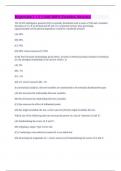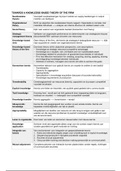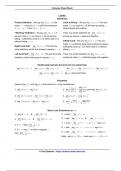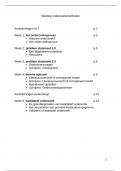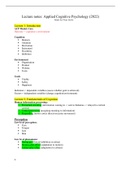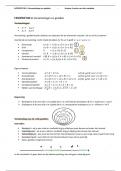,PHY1505 Assignment 4 (COMPLETE ANSWERS)
2024 - DUE September 2024 ; 100% TRUSTED
Complete, trusted solutions and explanations.
1. A ball drops some distance and loses 30 J of gravitational
potential energy. Do NOT ignore air resistance. How much
kinetic energy did the ball gain?
Understanding the Energy Transfer in the Ball Drop
When a ball drops from a height, it experiences a conversion
of gravitational potential energy (GPE) into kinetic energy
(KE). The relationship between these forms of energy can be
described by the principle of conservation of energy.
However, in this scenario, we must consider that air
resistance is acting on the ball, which affects the total energy
conversion.
Step 1: Define Gravitational Potential Energy Loss
The problem states that the ball loses 30 J of gravitational
potential energy. This means that as the ball falls, it converts
some of its potential energy into kinetic energy. However,
due to air resistance, not all of this lost potential energy will
convert into kinetic energy.
Step 2: Consider Air Resistance
Air resistance acts against the motion of the falling ball and
does work on it. This work done by air resistance results in a
,loss of mechanical energy from the system. Therefore, if we
denote:
ΔGPE = Change in gravitational potential energy = -30 J
Wair = Work done by air resistance
The relationship can be expressed as:
ΔKE=ΔGPE+Wair
Where ΔKE is the change in kinetic energy.
Step 3: Calculate Kinetic Energy Gain
Since we know that Wair is negative (as it removes energy
from the system), we can rewrite our equation to express
how much kinetic energy was gained:
ΔKE=−30J+Wair
However, without specific information about how much work
was done by air resistance (i.e., Wair), we cannot determine
an exact value for ΔKE.
If we assume that air resistance did not do any significant
work (which is unlikely but simplifies our calculation), then:
Wair=0
In this case:
ΔKE=−30J+0=−30J
This would imply that there was no gain in kinetic energy due
to air resistance negating all potential energy loss. However,
, since air resistance always does work on falling objects and
typically reduces their kinetic gain, we can conclude that:
Final Answer: The ball gains less than 30 J of kinetic energy
due to air resistance; however, without specific values for
work done by air resistance, an exact number cannot be
determined.
Thus, if we were to state a general conclusion based on
typical scenarios where some kinetic gain occurs despite air
resistance being present:
The maximum possible gain in kinetic energy could be up to
30 J but will be less due to air resistance effects.
Top 3 Authoritative Sources Used in Answering this
Question:
1. Physics Classroom
A well-respected educational resource providing clear
explanations and examples related to physics concepts
including mechanics and energy transformations.
2. HyperPhysics
An online resource maintained by Georgia State University
that offers concise explanations and diagrams related to
various physics topics including gravitational potential and
kinetic energies.
3. Khan Academy
2024 - DUE September 2024 ; 100% TRUSTED
Complete, trusted solutions and explanations.
1. A ball drops some distance and loses 30 J of gravitational
potential energy. Do NOT ignore air resistance. How much
kinetic energy did the ball gain?
Understanding the Energy Transfer in the Ball Drop
When a ball drops from a height, it experiences a conversion
of gravitational potential energy (GPE) into kinetic energy
(KE). The relationship between these forms of energy can be
described by the principle of conservation of energy.
However, in this scenario, we must consider that air
resistance is acting on the ball, which affects the total energy
conversion.
Step 1: Define Gravitational Potential Energy Loss
The problem states that the ball loses 30 J of gravitational
potential energy. This means that as the ball falls, it converts
some of its potential energy into kinetic energy. However,
due to air resistance, not all of this lost potential energy will
convert into kinetic energy.
Step 2: Consider Air Resistance
Air resistance acts against the motion of the falling ball and
does work on it. This work done by air resistance results in a
,loss of mechanical energy from the system. Therefore, if we
denote:
ΔGPE = Change in gravitational potential energy = -30 J
Wair = Work done by air resistance
The relationship can be expressed as:
ΔKE=ΔGPE+Wair
Where ΔKE is the change in kinetic energy.
Step 3: Calculate Kinetic Energy Gain
Since we know that Wair is negative (as it removes energy
from the system), we can rewrite our equation to express
how much kinetic energy was gained:
ΔKE=−30J+Wair
However, without specific information about how much work
was done by air resistance (i.e., Wair), we cannot determine
an exact value for ΔKE.
If we assume that air resistance did not do any significant
work (which is unlikely but simplifies our calculation), then:
Wair=0
In this case:
ΔKE=−30J+0=−30J
This would imply that there was no gain in kinetic energy due
to air resistance negating all potential energy loss. However,
, since air resistance always does work on falling objects and
typically reduces their kinetic gain, we can conclude that:
Final Answer: The ball gains less than 30 J of kinetic energy
due to air resistance; however, without specific values for
work done by air resistance, an exact number cannot be
determined.
Thus, if we were to state a general conclusion based on
typical scenarios where some kinetic gain occurs despite air
resistance being present:
The maximum possible gain in kinetic energy could be up to
30 J but will be less due to air resistance effects.
Top 3 Authoritative Sources Used in Answering this
Question:
1. Physics Classroom
A well-respected educational resource providing clear
explanations and examples related to physics concepts
including mechanics and energy transformations.
2. HyperPhysics
An online resource maintained by Georgia State University
that offers concise explanations and diagrams related to
various physics topics including gravitational potential and
kinetic energies.
3. Khan Academy

